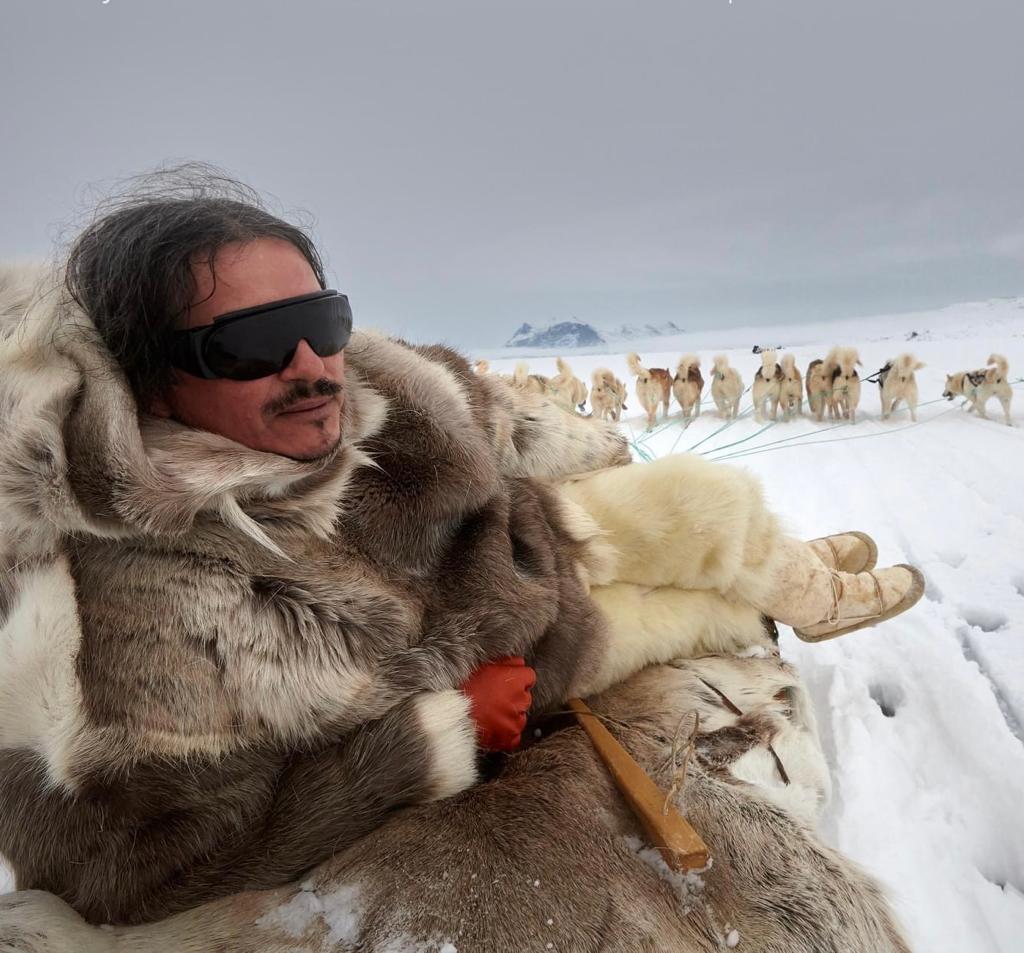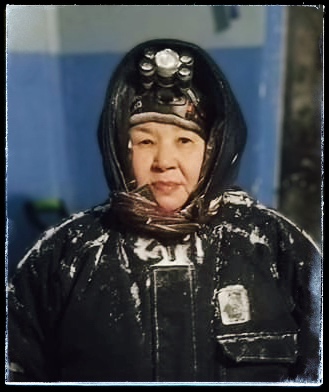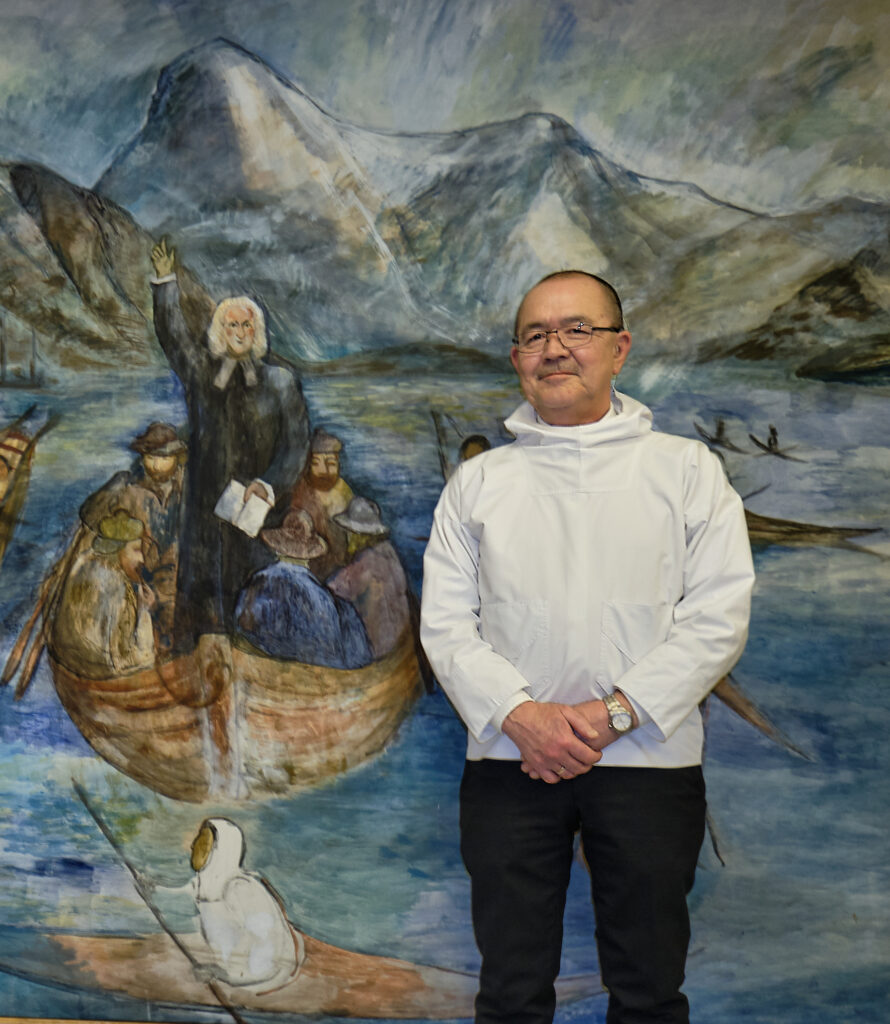
Uuli Joorut (Greenland – Kalaallisut)
a.k.a Ole Jørgen Hammeken
Principal Arctic Cultural Advisor to Flights of the Angakok
In memoriam
Lera captured the very essence of the Shamanism of the Old Inuit and she can see things just like them. It’s not about words, it’s about the essence, the message. But it is also about the words too. When I was just invited into this project, I was skeptical. But once I read the Libretto, I understood that she is the person who was able to go deep into the time in the essence of the extraordinary abilities of the Shamans. Her love for them and her understanding of their doings are condensed into the words that she is using. – Uuli Joorut (Greenland)
Ole Jorgen Hammeken is an Inuit explorer, actor, author, and educator. Born in Nuuk, Greenland, in 1956, he has led and participated in numerous Arctic expeditions, including the remarkable feat of circumnavigating the Arctic Ocean in a small open boat. The world’s northernmost mountain in Peary Land, Hammeken Point, was named in his honor. A fellow international of The Explorers Club, he is renowned for his roles as a screenwriter and the lead actor portraying the great polar bear hunter Ikuma in the Greenlandic film „INUK,“ which has garnered over twenty accolades at international film festivals. Hammeken is a sought-after expert on indigenous issues and has been featured on various media platforms, including BBC, Euronews, CBS, and National Geographic. Hammeken is a co-founder of Expedition Avannaa, an eyewitness cultural expedition to the world’s most isolated communities affected by climate and societal change, and Arctic Without Borders, an initiative in citizen diplomacy that seeks to foster cultural connections between the smallest circumpolar communities through collaborative efforts and the exchange of knowledge.

Piita Taqtu Irniq (Nunavut – Inuktitut)
About choirs of Europeans singing in the native tongues of the Indigenous People of the Arctic:
Piita Taqtu Irniq (Nunavut)
They just have to sing it the best way they can by reading the words. It has been done.
It has been done by Inuit also, who no longer speak Inuktut.*
Thank you very much for having me help you out.
* The shifting Arctic narrative is underscored by a poignant reality where newer generations of Inuit are increasingly detached from their ancestral language.

Apa Yatta (Chukotka – Yup’ik)
Apa Yatta is a Siberian Yupik heritage taker, teacher, crafts maker, storyteller and cultural influencer in Chukotka.
She is a descendant of Yupik traditional hunters and drum dancers from the ancient Inuit settlement Ungayiq, who were forcefully relocated by the Soviet authorities to Novoye Chaplino in the late 1950s. This tragic relocation of the Yupik population is often referred to as “the end of the Eskimo land”.
Born in Tasiq on the shore of the Bering Sea, Apa Yatta was sent to the residential school in Provideniya, where the indigenous children were expected to be assimilated, “civilized”, and Russified into a colonial culture in the interests of the Soviet Government.
Despite the difficult circumstances, Apa invested her life into keeping the rich indigenous cultural ways of being, knowing and doing by learning and promoting the Inuit culture in her native Chukotka and around the world. Apa’s sister lives in Alaska but can not see each other because the Ice Curtain separating Inuit communities on both sides of the Bering Strait is back in place.

Suuluaraq (Greenland – Avanersuarmiutut / Inuktun)
a.k.a Søren Hans Lynge
Suuluaraq, the Inuit cultural teacher and political activist, was born in Qaqortoq, Greenland, into a family of famous artists and influential spiritual leaders. In his early childhood, his parents moved to Qaanaaq, the world’s northernmost town in Thule District, where Suuluaraq learned Avanersuarmiutut, the language spoken by approximately 1,000 indigenous Inughuit (Polar Inuit), formerly known as Arctic Highlanders.
Sometimes called Thule Dialect, Avanersuarmiutut dialectologically lies between the Greenlandic official language (Kalaallisut) and the Canadian Inuktitut, Inuvialuktun or Inuinnaqtun.
Speaking fluently Danish, English, and his two native Inuit languages, Suuluaraq felt like an „outcast“ when he was sent to Denmark as a part of „Experiment“, a Danish attempt to re-educate Greenlandic Inuit children as „little Danes“. As a result, the relocated children experienced extensive cultural isolation, and many lost their sense of purpose in life.
After his forced journey to Denmark, Suuluaraq was sure about his life mission: to pass down traditional knowledge, grow Inuit influence, and teach others about his people’s history, culture, and language.

Victor Yedne (Yamal Peninsula – Nenets).
Victor Yadne is Nenets mammoth tusk carver. He was born in the tundra on the Yamal peninsula, whose name means “the edge of land”: everything North is the Arctic Ocean. At six, Victor was deprived of his Nenets name when he was forcibly sent to the Soviet residential school to be re-educated and Russified. His return to his roots and birth name Valyoy, which literally means “a great crafts maker”, took years. His awakening began in his backyard, filled with mammoth tusks. With climate change and permafrost melt, tundra revealed more millennia-old carcasses. “Useless” bones, not needed by anyone at that time, were transforming in Victor’s hands into polar bears and whales, reindeer herders, living in unison with the Arctic nature and Shamans that could fly above and below the frozen land and water and see the past and the future alike.
Victor’s works are kept in the world’s major museums and private collections today. Victor believes that the indigenous language and nature are one: “Once you lose the language, you lose the lifestyle. And the art won’t survive much longer”.

Lars-Emil Johansen (Greenland – Kalaallisut)
Lars-Emil Johansen is a towering figure in Greenland’s modern history. He served as the second prime minister of Greenland from 1991 to 1997, and Speaker of the Inatsisartut from 2013 to 2018. Johansen was chairman of the political party Siumut between 1987 and 1997, seated in the Landsting from its creation in 1979
Born in Illorsuit, a little settlement, immortalized by Rockwell Kent for the Western society, he grew up studying complexities of ice of a frozen ocean, and learning early the power of impermanence. Illorsuit is now an abandoned place – due both to climate change and the advance global civilization, and a magnifying glass of Greenland’s history and Lars-Emil’s own life and career in public service.
One of the “Trinity of Three Polar Bears” – who had secured for Greenland its Home Rule, Lars-Emil Johansen started as a “revolutionary”, breaking rules and stereotypes, and revolting against Danish monopoly. His linguistic skills were superb, he was easily winning his anticolonialist debates with the sharpest of Danish politicians and reporters. But as an Inuit, he knew well the power of balance, the skill the young kids are taught here before they make the first step. A child of Illorsuit “polar bear hunters’ aristocracy”, he eventually became the Father of the Nation, admired by the right and the left, young and old, being continuously chosen a Prime Minister and the President of the Parliament for decades.Today, at 77, a grandfather of many, a talented musician and singer, inseparable with his accordion, Lars-Emil Johansen keeps containing Greenland with his storytelling, music and wisdom on the way to the country’s full independence.

Ymma Selyakin (Chukotka – Yupik)
Ymma is a Yupik elder, language teacher, performer and crafts maker. Yma was born in 1950 in a village of Unazik, in the family of a traditional Yupik sea mammal hunters. When she was admitted to the Soviet residential school, she was told to forget her own name and was given a Russian name, Valentina Selyakina, instead. A millennia old Unazik was classified as a “settlement with no future“ and closed by Soviet Authorities in 1959.
Later trained as a nurse, Yma spent her life in the ambulance posts caring for her indigenous neighbors, observing how quickly they were losing their language and heritage.
A talented linguist, Yma managed to memorize many of the old Yupik stories told by her grandparents and their friends, in different dialects. Today, at 73, she is one of a few Yupik elders, who can speak the rich Yupik language once spoken here before, before the arrival of the colonizers.
Yma says that their language will never survive without art, songs and dances, the old culture that is quickly fading. Most of Yupik dances illustrate the scenes from everyday life: Walrus Dance, Whale Dance and Raven Dance. She performs them together with young indigenous children in their local band called Sik’inyk, which simply means “Little Sun”.

Payna Nanok (Chukotka – Yupik)
Payna Nanok (her Russified name is Galina Povolskhikh) is a Yupik elder, cultural teacher, linguist, and radio host. She was born and raised in Unazik, the old Inuit settlement in Chukotka. In 1959, at the age of 17, she was forcefully moved along with her family to Tasik, also known as Novoye Chaplino. After being trained as a teacher, she has become a part of a resurgence of the Yupik language and culture in the education system, placing emphasis not solely on language and dialects but also on cultural identity, values, and wellness. She has been instrumental in the creation of new Yupik dictionaries, guides, and children’s books. She regularly speaks on Yupik radio and teaches the Yupik language online.
Tynga Tagitutkak (Chukotka – Yupik)

Valentina Koonooka (Alaska, St. Lawrence Island – Central Siberian Yupik, Chaplino Dialect)
